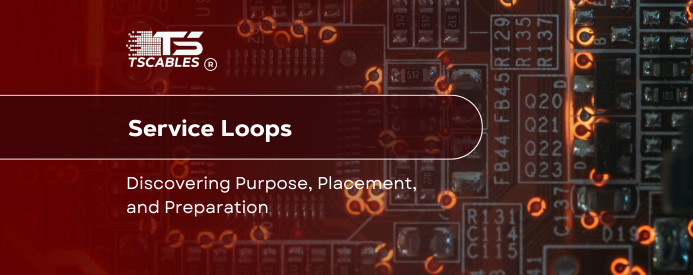You’ve probably seen that there is a bit of extra cable coiled up at the end of a run. That’s not an accident. It’s called a service loop, and it can save time, money, and stress. Service loops are used during cable installs to make things easier down the road in homes, data centers, and other places.
If you’re dealing with Ethernet cable installation services or basic home wiring, then knowing how and why to leave that extra bit of wire can make a world of difference. Luckily for you, this article provides you with a comprehensive idea about service loops. Let’s explore the real purpose of a service loop, where it belongs, and how to make it right.
What is a Service Loop in Wiring?
A service loop is a loop of extra cable that’s purposely left during installation. It gives you slack in the line. That slack makes it easier to move, repair, or replace parts of the system later on. You’ll find service loop wiring in many places, such as behind wall plates, near switches, outside buildings, and inside telecom closets.
These loops are useful in electrical, data, and fiber jobs. Whether it’s an electrical service loop on a pole or a coiled network cable in a ceiling, they all serve the same goal, and that is flexibility.
You’ll also spot loops in fiber setups. In a fiber switching loop, for instance, they help with patching and upgrades. With loop networking, that little circle of slack keeps future work simple and safe.
Role of Using a Service Loop in Wiring
What’s the big deal with leaving a few extra feet of cable? Well, the answer is going to surprise you. Here’s why service loops matter:
- They let you move the gear without re-pulling the cable.
- They reduce strain on connectors and ports.
- They give space for re-termination or repairs.
- They help with cable management services by keeping wires neat.
- They reduce the need to cut and splice later.
It is safe to say that you can consider the loop service as a buffer. It’s the extra inch you didn’t know you needed until you did.
Steps Required to Create a Proper Service Loop
Creating a proper service loop is more than just about leaving extra wire. It’s about doing it the right way from start to finish. The process is simple, but every step matters. From measuring and placing to coiling and testing, each part ensures the loop does its job without causing future issues.
Step 1: Measure Your Cable Length Properly
Always add slack before you cut. Plan for at least 12–24 inches of extra cable for your service loop electrical. More for long runs or hard-to-reach places.
Step 2: Choose the Loop Placement
Put the wire service loop in a spot that’s easy to reach but out of the way. Inside wall boxes, server racks, and ceiling panels are good choices. Outdoor loops should include a cable drip loop to stop water from sneaking into your setup.
Step 3: Coil the Cable Gently
It is important that the loop should be smooth and round, think soft curl, not tight knot. This keeps your cable with loops safe from breakage.
Step 4: Secure It Cleanly
Use Velcro, not zip ties. You want to avoid pinching the cable. Label the ends clearly. It’s a smart move for cable management service work later on.
Step 5: Test the Line
Before buttoning everything up, always test the cable. A tight loop or damaged bend can mess with your Ethernet wiring service and cause signal loss.
Industry Guidelines for Service Loops
According to American National Standards Institute and Telecommunications Industry Association standards (ANSI/TIA) , both home and business cable installations require specific slack amounts for future upgrades or repairs.
Guidelines for Residential Properties
For homes (per ANSI/TIA 570-D), leave at least 3 feet of slack at the media enclosure and 8 inches at each outlet, storing any extra inside the wall or outlet box. Ethernet cables like U/UTP should be stored in a figure “8” pattern, not coiled.
Guidelines for Commercial Properties
For commercial sites (ANSI/TIA 568.0-E and BICSI ITSIMM 8th Edition), pull enough slack to reach the farthest corner of the telecom room, plus the floor-to-ceiling height. At outlets, leave 1.6 feet (20 inches) and keep the rest inside the wall. Again, always use a figure “8” pattern when storing on racks or fixtures—never a coil.
Common Mistakes to Avoid When Installing a Service Loop
Even a good idea can go bad if done wrong. Therefore, it is highly important that you avoid the common mistakes that people make when installing a service loop. Watch out for these slip-ups:
- Leaving too much cable in the loop creates clutter and heat.
- Making the loop too tight will lead to damage to the cable internally.
- Forgetting to secure the loop means that it will end up in a tangled mess later.
- Placing loops near electrical gear can cause interference.
- Ignoring outdoor protection can be a grave mistake, as no cable drip loop means water trouble.
A little planning beats a big headache down the road. Treat every looped service like it matters because it does.
Conclusion
A service loop is simple but smart. It gives breathing room to your wiring job and makes fixes easier. Skip the hassle later and do it right from the start. Want to upgrade your setup? Reach out to TS Cables to find the right cables and relevant accessories for your networking needs.
FAQs
Q1: What is a cable drop?
A cable drop is where a cable comes down from a ceiling or up from the floor to connect to a device.
Q2: What to do with Slack BX cables?
Tuck them in a safe spot, form a gentle service loop, and avoid placing them near heat or power sources.
Q3: What is a loop in network setups?
It’s a setup where data paths can loop back on themselves, which can create problems if not managed.
Q4: What are cable loop ends used for?
They give extra room for future cable movement, device swapping, or testing without full rewiring.
Q5: Why do cables have loops on each end?
To keep the cable flexible for both installation and maintenance. It’s all about making life easier later.






